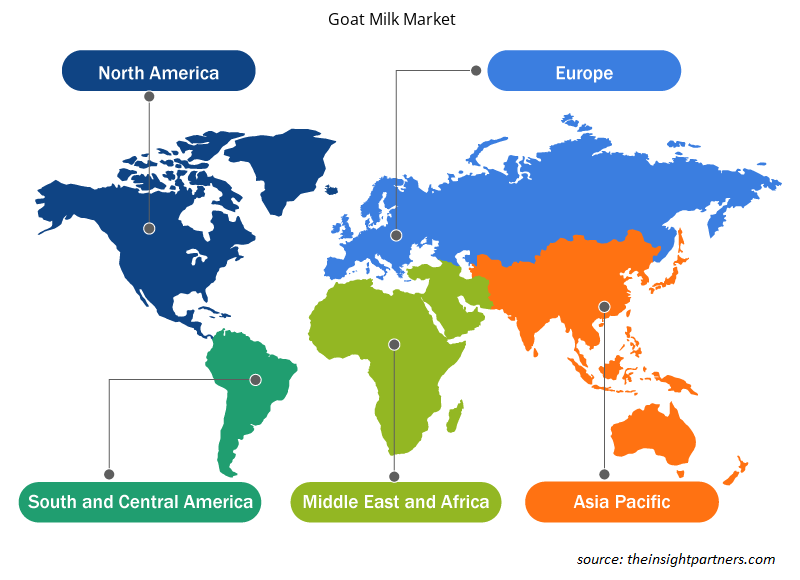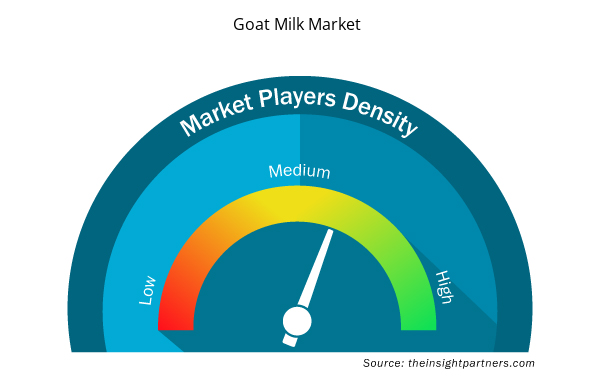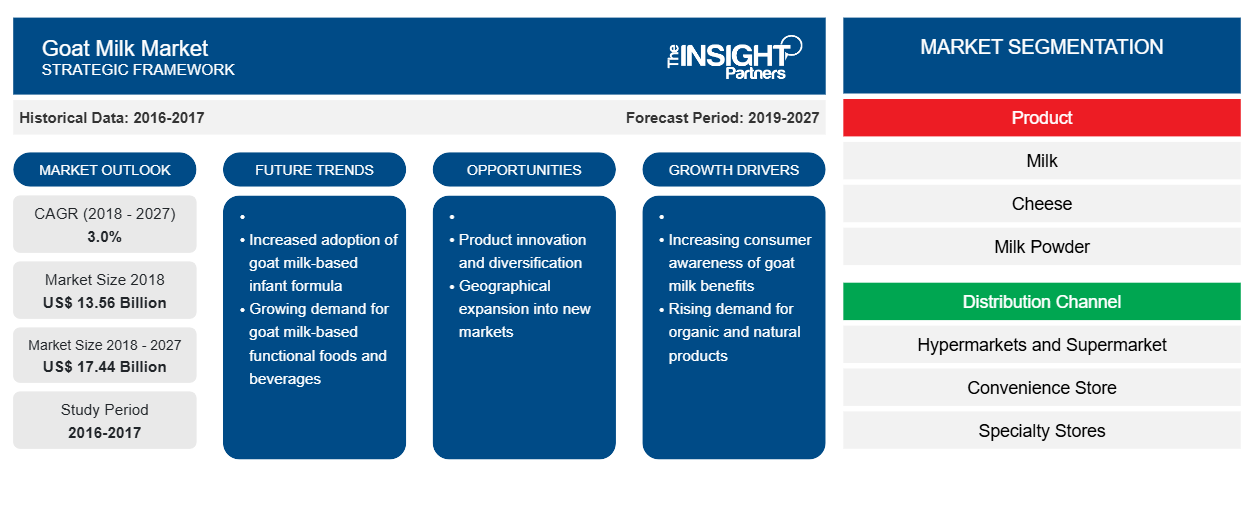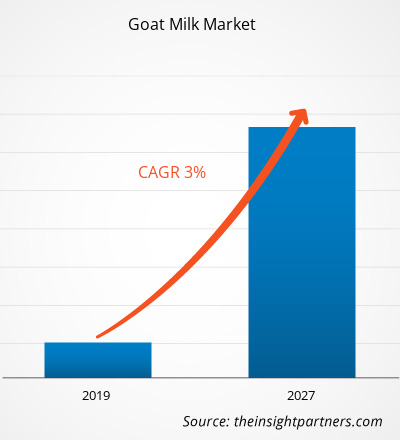El mercado de leche de cabra se valoró en US$ 13.559,5 millones en 2018 y se espera que crezca a una CAGR del 3,0% entre 2019 y 2027 para alcanzar los US$ 17.440,7 millones en 2027.CAGR of 3.0% from 2019 to 2027 to reach US$ 17,440.7 million by 2027.
La leche de cabra es muy nutritiva y contiene minerales vitales. También contiene vitaminas y mayores cantidades de potasio, hierro y vitamina A que la leche de vaca. La leche de cabra es muy saludable, tiene una composición proteica similar a la de la leche materna humana y es más digerible que la leche de vaca. La leche de cabra es popular en la industria del cuidado personal y se utiliza en una gran cantidad de productos cosméticos. Como la leche de cabra tiene un pH neutro natural y ácido láctico natural, se prefiere en la fabricación de productos para el cuidado de la piel, como lociones, jabones, cremas y limpiadores. El alto contenido natural de grasa en la leche de cabra la convierte en un excelente humectante para la piel. Por lo tanto, se espera que la creciente popularidad de la leche de cabra en la industria del cuidado personal impulse el crecimiento del mercado de la leche de cabra .
América del Norte representó la mayor parte del mercado mundial de leche de cabra. La creciente atención hacia el valor nutricional de los productos lácteos, el aumento de las preocupaciones por la salud y el aumento de la popularidad de la leche de cabra debido a los versátiles beneficios para la salud son los factores importantes que se espera que impulsen el crecimiento del mercado mundial de la leche de cabra durante el pronóstico. La transformación de los hábitos alimentarios y de bebidas, las necesidades alimentarias modernas y el estilo de vida rápido y saludable de los habitantes tienen una influencia notable en el mercado de la leche de cabra en la región de América del Norte.
Personalice este informe según sus necesidades
Obtendrá personalización en cualquier informe, sin cargo, incluidas partes de este informe o análisis a nivel de país, paquete de datos de Excel, así como también grandes ofertas y descuentos para empresas emergentes y universidades.
- Obtenga las principales tendencias clave del mercado de este informe.Esta muestra GRATUITA incluirá análisis de datos, desde tendencias del mercado hasta estimaciones y pronósticos.
Perspectivas del mercado
Los beneficios para la salud que ofrece la leche de cabra están provocando un aumento de la demanda de leche de cabra a nivel mundial
Se ha demostrado que un vaso de leche, que ayuda a cubrir las necesidades diarias de grasa y calcio del cuerpo humano, mejora la inmunidad y el metabolismo. Sin embargo, algunos consumidores sufren problemas gástricos debido a la intolerancia a la lactosa presente en la leche de vaca. Los nutricionistas recomiendan la leche de cabra en lugar de la leche de vaca a los consumidores intolerantes a la lactosa, ya que la primera tiene un contenido de azúcar relativamente menor. Además, no causa malestar estomacal ni acidez y se digiere fácilmente. La leche de cabra cruda ayuda a curar varias enfermedades, ya que ayuda a aumentar el recuento de plaquetas en las infecciones causadas por el dengue y otros virus. Además, es una buena fuente de calostro y también se considera un remedio natural para la ictericia. Las propiedades antiinflamatorias que imparte esta leche son únicas debido a su composición enzimática que controla meritoriamente la inflamación intestinal.
Información sobre el producto
El mercado de la leche de cabra está segmentado en función de la leche, el queso, la leche en polvo y otros. El mercado mundial de la leche de cabra basado en el producto fue liderado por el segmento de la leche y tuvo la mayor participación de mercado. El mercado de la leche de cabra está impulsado por factores como el aumento de las preocupaciones por la salud entre los consumidores y la creciente demanda de leche de cabra en la industria del cuidado personal. La leche de cabra es una bebida nutritiva con vitaminas y minerales esenciales, que proporciona múltiples beneficios para la salud. La leche de cabra contiene una mayor cantidad de potasio, calcio, hierro y vitamina A que la leche de vaca. Además, la leche de cabra contiene menos lactosa que la leche de vaca, se digiere fácilmente y la leche de cabra tiene mucho calcio, colesterol más bajo y es una buena fuente de vitaminas esenciales. La demanda del mercado de la leche de cabra está impulsada principalmente por los diversos beneficios nutricionales que ofrece. La leche de cabra también ayuda a curar muchas enfermedades y se utiliza para mejorar el recuento de plaquetas durante las infecciones virales, ya que tiene anticuerpos y se considera una cura natural para la ictericia.
Información sobre el canal de distribución
El mercado de la leche de cabra está segmentado en función del canal de distribución en hipermercados y supermercados, tiendas de conveniencia, tiendas especializadas, tiendas en línea y farmacias y tiendas médicas. El mercado mundial de la leche de cabra basado en el canal de distribución estuvo liderado por el segmento de tiendas especializadas y tuvo la mayor participación de mercado. Las tiendas especializadas son las tiendas minoristas que se centran en ofrecer categorías de productos específicos. Las tiendas especializadas para productos lácteos se dedican principalmente a la venta de productos lácteos como leche, mantequilla, queso, yogur, requesón y helado. Estas tiendas también brindan una excelente experiencia al consumidor con características únicas como servicio al cliente de alto nivel, ofertas premium y descuentos especiales.
Las empresas suelen adoptar iniciativas de mercado y fusiones y adquisiciones para expandir su presencia en todo el mundo, lo que repercute aún más en el tamaño del mercado. Los actores presentes en el mercado de la leche de cabra adoptan la estrategia de iniciativas de mercado y fusiones y adquisiciones para ampliar la base de clientes y ganar una cuota de mercado significativa en todo el mundo, lo que también les permite mantener su marca a nivel mundial.
Perspectivas regionales del mercado de la leche de cabra
Los analistas de Insight Partners explicaron en detalle las tendencias y los factores regionales que influyen en el mercado de la leche de cabra durante el período de pronóstico. Esta sección también analiza los segmentos y la geografía del mercado de la leche de cabra en América del Norte, Europa, Asia Pacífico, Oriente Medio y África, y América del Sur y Central.

- Obtenga los datos regionales específicos para el mercado de leche de cabra
Alcance del informe sobre el mercado de la leche de cabra
| Atributo del informe | Detalles |
|---|---|
| Tamaño del mercado en 2018 | US$ 13,56 mil millones |
| Tamaño del mercado en 2027 | US$ 17,44 mil millones |
| Tasa de crecimiento anual compuesta (CAGR) global (2018-2027) | 3.0% |
| Datos históricos | 2016-2017 |
| Período de pronóstico | 2019-2027 |
| Segmentos cubiertos | Por producto
|
| Regiones y países cubiertos | América del norte
|
| Líderes del mercado y perfiles de empresas clave |
|
Densidad de actores del mercado de leche de cabra: comprensión de su impacto en la dinámica empresarial
El mercado de la leche de cabra está creciendo rápidamente, impulsado por la creciente demanda de los usuarios finales debido a factores como la evolución de las preferencias de los consumidores, los avances tecnológicos y una mayor conciencia de los beneficios del producto. A medida que aumenta la demanda, las empresas amplían sus ofertas, innovan para satisfacer las necesidades de los consumidores y aprovechan las tendencias emergentes, lo que impulsa aún más el crecimiento del mercado.
La densidad de actores del mercado se refiere a la distribución de las empresas o firmas que operan dentro de un mercado o industria en particular. Indica cuántos competidores (actores del mercado) están presentes en un espacio de mercado determinado en relación con su tamaño o valor total de mercado.
Las principales empresas que operan en el mercado de la leche de cabra son:
- Lechería Delamere
- Grupo Emmi
- Lechería Hay Pte Ltd.
- Kavli
- Socios de cabras internacionales, inc.
Descargo de responsabilidad : Las empresas enumeradas anteriormente no están clasificadas en ningún orden particular.

- Obtenga una descripción general de los principales actores clave del mercado de la leche de cabra
Mercado mundial de leche de cabra: por producto
- Leche
- Queso
- Leche en polvo
- Otros
Mercado mundial de leche de cabra: por canal de distribución
- Hipermercados y Supermercados
- Tiendas de conveniencia
- Tiendas especializadas
- En línea
- Tiendas de medicamentos y farmacias
Perfiles de empresas
- Lechería Delamere
- Grupo Emmi
- Lechería Hay Pte Ltd.
- Kavli
- Socios de cabras internacionales, inc.
- Corporación Láctea Ausnutria Ltd.
- Lechería Stickney Hill, Inc.
- Grupo Granarolo
- Granja lechera de cabras Summerhill
- Cooperativa de Alimentos Gay Lea Ltd.
- Análisis histórico (2 años), año base, pronóstico (7 años) con CAGR
- Análisis PEST y FODA
- Tamaño del mercado Valor/volumen: global, regional, nacional
- Industria y panorama competitivo
- Conjunto de datos de Excel



Report Coverage
Revenue forecast, Company Analysis, Industry landscape, Growth factors, and Trends

Segment Covered
This text is related
to segments covered.

Regional Scope
North America, Europe, Asia Pacific, Middle East & Africa, South & Central America

Country Scope
This text is related
to country scope.
Preguntas frecuentes
Essential vitamins such as A, B1, B2, B3, and minerals such as calcium and phosphorous are predominantly present in the goat milk. Also, the goat milk contains less lactose than cow’s milk, it is easily digested, and the goat milk has plenty of calcium, lower cholesterol, and is a good source of essential vitamins. The demand for goat milk market is primarily driven by the various nutritional benefits offered by it. The goat milk also helps in curing a lot of diseases, and it is used to improve the platelet count during viral infections as it has antibodies and is considered a natural cure for jaundice.
Goat milk lead the global goat milk market. Goat milk is a nutritious drink with essential vitamins and minerals, which provides multiple health benefits. Goat milk contains higher amount of potassium, calcium, iron, and vitamin A than cow’s milk. The goat milk market is driven by factors such as increasing health concerns among consumers, increasing awareness about the medicinal benefits of the goat milk, and increasing demand for goat milk in the personal care industry.
The goat milk market was dominated by North America. The largest number of milk goats are found in Wisconsin (44,000 head), Iowa (30,000 head), California (41,000 head), New York (13,700 head), and Pennsylvania (15,000 head). In 2018, the milk goat count in the US went up to 380,000, which accounted for 16% of the global milk goats. Every state in the US has its own goat breeders’ association, and there are several national organizations, magazines, and websites which promote goat milk products such as goat cheeses, cosmetics, and candy products.
Trends and growth analysis reports related to Food and Beverages : READ MORE..
The List of Companies - Goat Milk Market
- Delamere Dairy
- Emmi Group
- Hay Dairies Pte Ltd.
- Kavli
- Goat Partners International, Inc.
- Ausnutria Dairy Corporation Ltd.
- Stickney Hill Dairy, Inc.
- Granarolo Group
- Summer Hill Goat Dairy
- Gay Lea Foods Co-operative Ltd.
The Insight Partners performs research in 4 major stages: Data Collection & Secondary Research, Primary Research, Data Analysis and Data Triangulation & Final Review.
- Data Collection and Secondary Research:
As a market research and consulting firm operating from a decade, we have published and advised several client across the globe. First step for any study will start with an assessment of currently available data and insights from existing reports. Further, historical and current market information is collected from Investor Presentations, Annual Reports, SEC Filings, etc., and other information related to company’s performance and market positioning are gathered from Paid Databases (Factiva, Hoovers, and Reuters) and various other publications available in public domain.
Several associations trade associates, technical forums, institutes, societies and organization are accessed to gain technical as well as market related insights through their publications such as research papers, blogs and press releases related to the studies are referred to get cues about the market. Further, white papers, journals, magazines, and other news articles published in last 3 years are scrutinized and analyzed to understand the current market trends.
- Primary Research:
The primarily interview analysis comprise of data obtained from industry participants interview and answers to survey questions gathered by in-house primary team.
For primary research, interviews are conducted with industry experts/CEOs/Marketing Managers/VPs/Subject Matter Experts from both demand and supply side to get a 360-degree view of the market. The primary team conducts several interviews based on the complexity of the markets to understand the various market trends and dynamics which makes research more credible and precise.
A typical research interview fulfils the following functions:
- Provides first-hand information on the market size, market trends, growth trends, competitive landscape, and outlook
- Validates and strengthens in-house secondary research findings
- Develops the analysis team’s expertise and market understanding
Primary research involves email interactions and telephone interviews for each market, category, segment, and sub-segment across geographies. The participants who typically take part in such a process include, but are not limited to:
- Industry participants: VPs, business development managers, market intelligence managers and national sales managers
- Outside experts: Valuation experts, research analysts and key opinion leaders specializing in the electronics and semiconductor industry.
Below is the breakup of our primary respondents by company, designation, and region:

Once we receive the confirmation from primary research sources or primary respondents, we finalize the base year market estimation and forecast the data as per the macroeconomic and microeconomic factors assessed during data collection.
- Data Analysis:
Once data is validated through both secondary as well as primary respondents, we finalize the market estimations by hypothesis formulation and factor analysis at regional and country level.
- Macro-Economic Factor Analysis:
We analyse macroeconomic indicators such the gross domestic product (GDP), increase in the demand for goods and services across industries, technological advancement, regional economic growth, governmental policies, the influence of COVID-19, PEST analysis, and other aspects. This analysis aids in setting benchmarks for various nations/regions and approximating market splits. Additionally, the general trend of the aforementioned components aid in determining the market's development possibilities.
- Country Level Data:
Various factors that are especially aligned to the country are taken into account to determine the market size for a certain area and country, including the presence of vendors, such as headquarters and offices, the country's GDP, demand patterns, and industry growth. To comprehend the market dynamics for the nation, a number of growth variables, inhibitors, application areas, and current market trends are researched. The aforementioned elements aid in determining the country's overall market's growth potential.
- Company Profile:
The “Table of Contents” is formulated by listing and analyzing more than 25 - 30 companies operating in the market ecosystem across geographies. However, we profile only 10 companies as a standard practice in our syndicate reports. These 10 companies comprise leading, emerging, and regional players. Nonetheless, our analysis is not restricted to the 10 listed companies, we also analyze other companies present in the market to develop a holistic view and understand the prevailing trends. The “Company Profiles” section in the report covers key facts, business description, products & services, financial information, SWOT analysis, and key developments. The financial information presented is extracted from the annual reports and official documents of the publicly listed companies. Upon collecting the information for the sections of respective companies, we verify them via various primary sources and then compile the data in respective company profiles. The company level information helps us in deriving the base number as well as in forecasting the market size.
- Developing Base Number:
Aggregation of sales statistics (2020-2022) and macro-economic factor, and other secondary and primary research insights are utilized to arrive at base number and related market shares for 2022. The data gaps are identified in this step and relevant market data is analyzed, collected from paid primary interviews or databases. On finalizing the base year market size, forecasts are developed on the basis of macro-economic, industry and market growth factors and company level analysis.
- Data Triangulation and Final Review:
The market findings and base year market size calculations are validated from supply as well as demand side. Demand side validations are based on macro-economic factor analysis and benchmarks for respective regions and countries. In case of supply side validations, revenues of major companies are estimated (in case not available) based on industry benchmark, approximate number of employees, product portfolio, and primary interviews revenues are gathered. Further revenue from target product/service segment is assessed to avoid overshooting of market statistics. In case of heavy deviations between supply and demand side values, all thes steps are repeated to achieve synchronization.
We follow an iterative model, wherein we share our research findings with Subject Matter Experts (SME’s) and Key Opinion Leaders (KOLs) until consensus view of the market is not formulated – this model negates any drastic deviation in the opinions of experts. Only validated and universally acceptable research findings are quoted in our reports.
We have important check points that we use to validate our research findings – which we call – data triangulation, where we validate the information, we generate from secondary sources with primary interviews and then we re-validate with our internal data bases and Subject matter experts. This comprehensive model enables us to deliver high quality, reliable data in shortest possible time.


 Obtenga una muestra gratuita de este informe
Obtenga una muestra gratuita de este informe